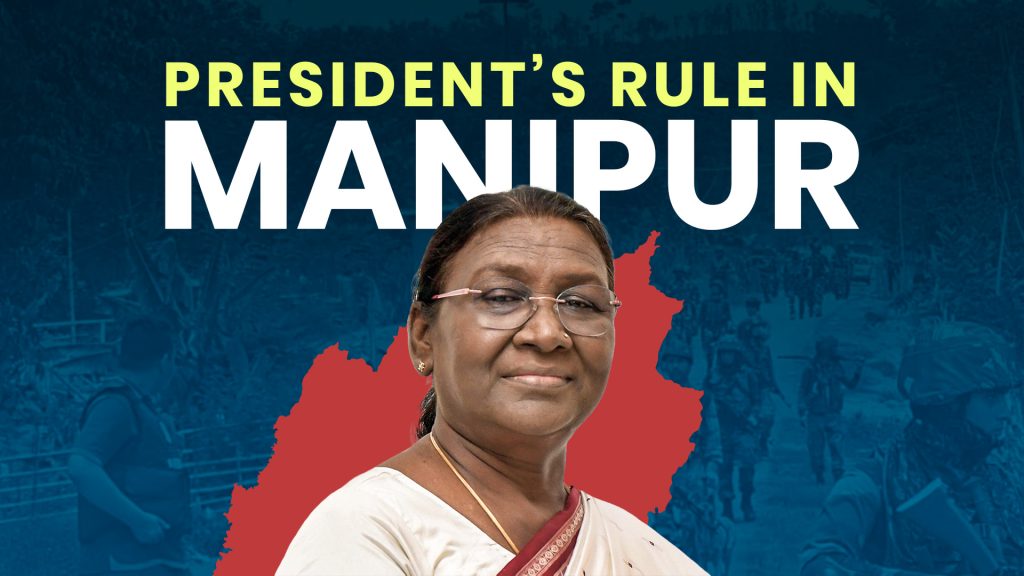SYLLABUS
GS-2: Structure, organization and functioning of the Executive and the Judiciary
Context:
Recently, Parliament has approved statutory resolution regarding the extension of President’s rule in Manipur for a further period of six months.
More on the News
For the extension of President’s Rule to take effect, both Houses of Parliament, including the Rajya Sabha, must pass the resolution.
Manipur was placed under President’s Rule in February 2025, following the resignation of the then Chief Minister, amid continued ethnic conflict.
The ongoing ethnic unrest in the state is primarily between:
- Meitei community (predominantly in the valley)
- Kuki-Zo tribal communities (based in the hills)
Until now, President’s Rule has been imposed 11 times in Manipur since 1967.
Emergency provisions are inspired from the German Constitution and outlined in Part XVIII of the Indian Constitution, protect India’s sovereignty, unity and security.
They empower the Central government to address extraordinary crises by temporarily assuming control to ensure stability and safeguard the democratic framework.
The Constitution provides for three types of emergencies — national (Article 352), State (Article 356) and financial (Article 360).
About the President’s rule
Article 356 of the Indian Constitution allows the President to take over the state government and legislature when the state’s government cannot function as per the Constitution.
- This fulfills obligation of Article 355 to protect States against ‘external aggression’ and ‘internal disturbance’ (such as separatist or sectarian violence or calamities beyond a State’s control) and to ensure that State governments operate as per the Constitution.
It is imposed when the President is “satisfied” (based on a report from the state’s Governor) that the government of a state cannot be carried on in accordance with the provisions of the Constitution (may not have any connection with war, external aggression or armed rebellion).
The President’s Rule can be proclaimed under Article 356 on two grounds–one mentioned in Article 356 itself and another in Article 365:
- Article 356 empowers the President to issue a proclamation, if he is satisfied that a situation has arisen in which the government of a state cannot be carried on in accordance with the provisions of the Constitution. Notably, the president can act either on a report of the governor of the state or otherwise too (ie, even without the governor’s report).
- Article 365 says that whenever a state fails to comply with or to give effect to any direction from the Centre, it will be lawful for the president to hold that a situation has arisen in which the government of the state cannot be carried on in accordance with the provisions of the Constitution.
Duration of President’s Rule
- Once approved, it remains effective for six months from the proclamation date, with further six-month extensions requiring additional Parliamentary approval.
- Renewal beyond one year is allowed only in certain conditions.
- However, in no case can the proclamation remain effective for more than three years, and the President may revoke or vary it at any time by a subsequent proclamation.
- Every resolution seeking approval or extension of President’s Rule must be passed by a simple majority in each House — that is, more than 50% of the members present and voting.
- If the Lok Sabha is dissolved during a six-month extension period without giving approval for further continuation, the proclamation will remain effective for 30 days from the first sitting of the newly elected Lok Sabha, provided Rajya Sabha approves the extension.
Conditions for Extension Beyond One Year
As per the 44th Constitutional Amendment Act, 1978, President’s Rule can be extended beyond one year (in six-month increments) only if:
- National Emergency is in force in the whole of India or in the state concerned.
- The Election Commission of India (ECI) certifies that holding Assembly elections in the concerned state is not feasible due to specific difficulties.
Revocation of President’s Rule
- The President can revoke the proclamation of President’s Rule at any time through a subsequent proclamation.
- Parliamentary approval is not required for revocation.
Implications of President’s rule
- During its operation, the state executive is dismissed, and the state legislature is either suspended or dissolved.
- The president administers the state through the governor and the Parliament makes laws for the state. In brief, the executive and legislative powers of the state are assumed by the Centre.
- It does not affect the Fundamental Rights of the citizens.



